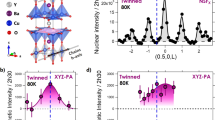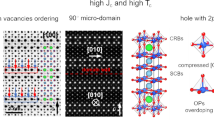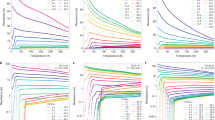Abstract
CuSe2 occurs in a room temperature form of the marcasite type1 and a high-pressure high-temperature modification of the pyrite type2. In both the marcasite and pyrite structures the cations are coordinated by six anions forming a distorted octahedron while the anions are bonded to three cations and another anion. In the pyrite structure the anion octahedra are connected by shared corners and in the marcasite structure the octahedra form chains by sharing edges. In the pyrites and the normal marcasites the deformation of the anion octahedra is not very marked. The marcasite family, however, has another branch, the loellingites, in which the deformation of the anion octahedra is much more pronounced and of opposite sign. The ratio of the octahedron edge parallel and perpendicular to the cation chains is roughly 1.1 in the normal marcasites and about 0.75 in the loellingites3,4. Different electronic structures of the cations account for the different distortions. Loellingites are found only in non-metallic phases containing d2 and d4 cations and distortions then result from the Jahn–Teller effect. Pyrites with dn cations occur for n≧5, while normal marcasites are known only for n≧6. In both the pyrite and the normal marcasite phases non-metallic properties are possible only if the cations have completely occupied d subbands, such as dε3dγ2, dε6, dε6dγ2 and d10. Examples of these configurations are MnS2, RuS2, NiS2 and ZnS2(p) respectively. (The symbols (r), (h), (p) indicate room temperature, high temperature and high pressure modifications, respectively.) Because large distortions would be required to separate the energies of the degenerate dγ states, all d7 and d9 phases are metallic and adopt either the pyrite or the normal marcasite structure.
This is a preview of subscription content, access via your institution
Access options
Subscribe to this journal
Receive 51 print issues and online access
$199.00 per year
only $3.90 per issue
Buy this article
- Purchase on Springer Link
- Instant access to full article PDF
Prices may be subject to local taxes which are calculated during checkout
Similar content being viewed by others
References
Gattow, G., Naturwiss., 52, 258 (1965); Z. Anorg. Allg. Chem., 340, 312 (1965).
Bither, T. A., Prewitt, C. T., Gillson, J. L., Bierstedt, P. E., Flippen, R. B., and Young, H. S., Solid State Comm., 4, 533 (1966); Bither, T. A., Second Int. Conf. Solid Comp. Transition Elements, (Twente, 1967).
Hulliger, F., and Mooser, E., Progr. Solid State Chem. (edit. by Reiss, H.), 2, 330 (Pergamon Press, 1965).
Hulliger, F., Structure and Bonding (edit. by Jørgensen, C. K., et al.), 4, 83 (Springer–Verlag, 1968).
Author information
Authors and Affiliations
Rights and permissions
About this article
Cite this article
HULL, G., HULLIGER, F. CuSe2, a Marcasite Type Superconductor. Nature 220, 257–258 (1968). https://doi.org/10.1038/220257a0
Received:
Issue Date:
DOI: https://doi.org/10.1038/220257a0
This article is cited by
-
Vacancy defect control of colossal thermopower in FeSb2
npj Quantum Materials (2021)
Comments
By submitting a comment you agree to abide by our Terms and Community Guidelines. If you find something abusive or that does not comply with our terms or guidelines please flag it as inappropriate.



